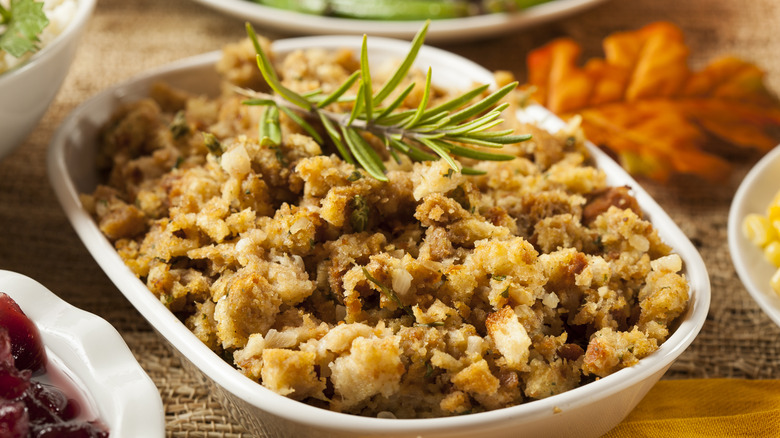Ina Garten's Genius Tip For Perfect Stuffing Without Overcooking Your Turkey
Cooking a tender, flavorful turkey can be a real challenge, especially when stuffing is involved. Fortunately, Ina Garten has a no-nonsense recommendation that can help you avoid bone-dry meat at your next big feast. The Barefoot Contessa suggests preparing the stuffing and turkey separately, as opposed to cooking the stuffing inside the cavity of the bird. Fun fact: Stuffing that's not made inside the turkey is technically called dressing, but not the kind you put on your salad. But more on that later.
Cooking a turkey with delicious cornbread and sausage stuffing tucked inside might be the traditional option, but it can spell disaster in the kitchen. The main issue here is ensuring your bird reaches safe internal temperatures, as turkey must reach an interior temperature of 165 degrees Fahrenheit for safe consumption. Any ingredients inside the turkey, i.e., the stuffing, must reach the same internal temperature, which requires an extended cooking time for the bird. That's how you wind up with an overcooked turkey, whereas Garten's method allows greater control over the doneness of both recipes.
How different cooking techniques affect the end result
If you crave a crispy texture when making stuffing, cooking the dish on its own is the best way to go. Consider that other celebrity chefs, such as Ree Drummond, co-sign Garten's tip about preparing the side dish separate from the turkey. According to The Pioneer Woman, Drummond stated that this technique creates "a better textured dressing," meaning it's capable of creating a crispier top layer than if you were cooking the ingredients inside the turkey. Drummond also described this dressing method as "less complicated" since you won't need to worry about balancing cooking times between the turkey and the stuffing.
When pondering the differences between stuffing and dressing, it's also worth noting that the two terms are often used interchangeably depending on where a person lives. Home chefs residing in the northern portion of the U.S. typically use the term stuffing, while Southerners and Midwesterners are fond of saying dressing. These names usually apply regardless of how the side dish is being prepared, but there are some regional distinctions to consider when comparing stuffing and dressing.
Variations on stuffing (and dressing) recipes
While there are no hard and fast rules on what stuffing ingredients belong to which regions of the country, regional influences can play a role in ingredient selection. For example, andouille sausage has strong links to Louisiana, so it's often included in stuffing recipes in the state. On the other hand, home chefs with reliable access to fresh seafood, such as those living on a coast, might choose to incorporate oysters into the mix.
Cornbread is a staple of Southern cooking, so it stands to reason that the food would appear in Southern dressing recipes. While many classic stuffing recipes call for white bread or something similar, southern chefs often use cornbread in its place. The use of cornbread imparts a rich, mildly sweet flavor that can elevate your dressing to another level. Conversely, stuffing recipes associated with the New England region of the U.S. sometimes forgo bread altogether and use saltine crackers instead. Whether you call it stuffing or dressing, stick with Garten's advice and prepare the dish separately for the best results.


